![]()
(última actualización - update)
![]()
|
NUMISMÁTICA Y MEDALLÍSTICA DE TIERRA DEL FUEGO, ARGENTINA
|
COINS AND MEDALS OF TIERRA DEL FUEGO, ARGENTINA
|
| Recopilación e Investigación: David N. F. Guevara | Compilation and research: David N. F. Guevara |
| Copyright © 1999-2011 David N.F.Guevara Todos los derechos reservados | Copyright © David N.F. Guevara, 1999–2011. All rights reserved. |
| Nota: Nuestro especial agradecimiento especial a David Sinclair de Helensburgh, Escocia, por su colaboración en la traducción de este enlace. |
![]()

| Arriba cuño Popper, foto David Guevara | Above, die for Popper's coin, photo David Guevara. |
![]()
|
¡AQUÍ SE ACUÑARON LAS MONEDAS DE ORO DE POPPER! - SERIE CASA DE MONEDA BUENOS AIRES, 1889 - |
HERE WERE MINTED POPPER'S GOLD COINS! – AT THE BUENOS AIRES MINT, 1889 – |
| Más abajo se incorporan cuatro (4) nuevas imágenes correspondientes a la antigua Casa de Moneda Buenos Aires (1881), edificio proyectado por el Ing. Eduardo Castilla y 1er. Director, ubicada en calle México esquina Defensa en el Barrio de Monserrat, Buenos Aires, Argentina. En este lugar Julio Popper hizo acuñar las famosas monedas de oro, serie Casa de Moneda de 1 gramo y 5 gramos, con oro nativo de El Páramo, Tierra del Fuego, Argentina. |
Below are three new views of the old Buenos Aires Mint (1881), a building designed by the engineer Eduardo Castilla and the first Master, located in calle México at the corner of calle Defensa in the Barrio de Monserrat, Buenos Aires, Argentina. It was here that Julio Popper had his famous gold coins of one and five grammes minted of the Mint series with giold from El Páramo, Tierra del Fuego, Argentina. |
IMAGEN -1-
VIEW –1–
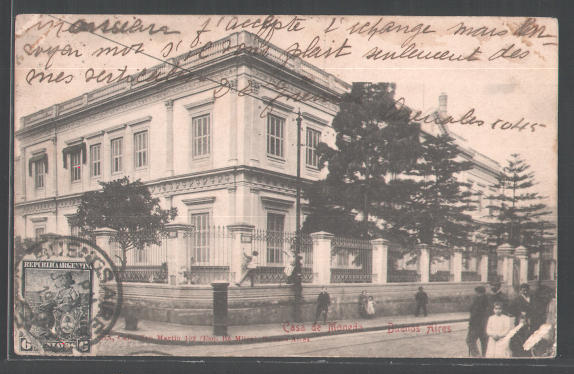
| Antigua postal Casa de Moneda Buenos Aires |
Old post card showing the Buenos Aires Mint. |
IMAGEN -2-
VIEW –2–
| Antigua postal Casa de Moneda Buenos Aires |
Old post card showing the Buenos Aires Mint. |
IMAGEN -3-
VIEW –3–
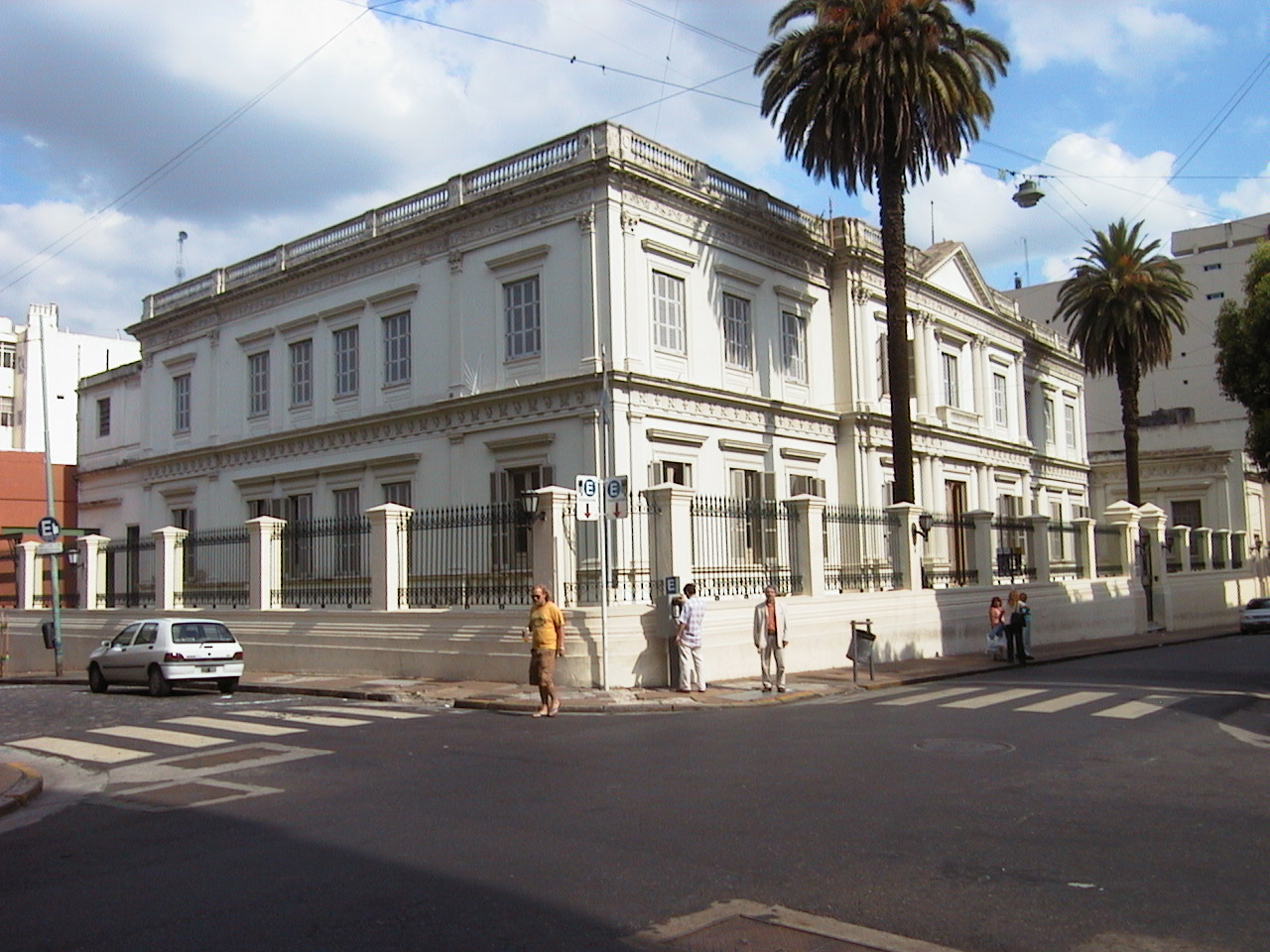
IMAGEN
-4-VIEW –4–
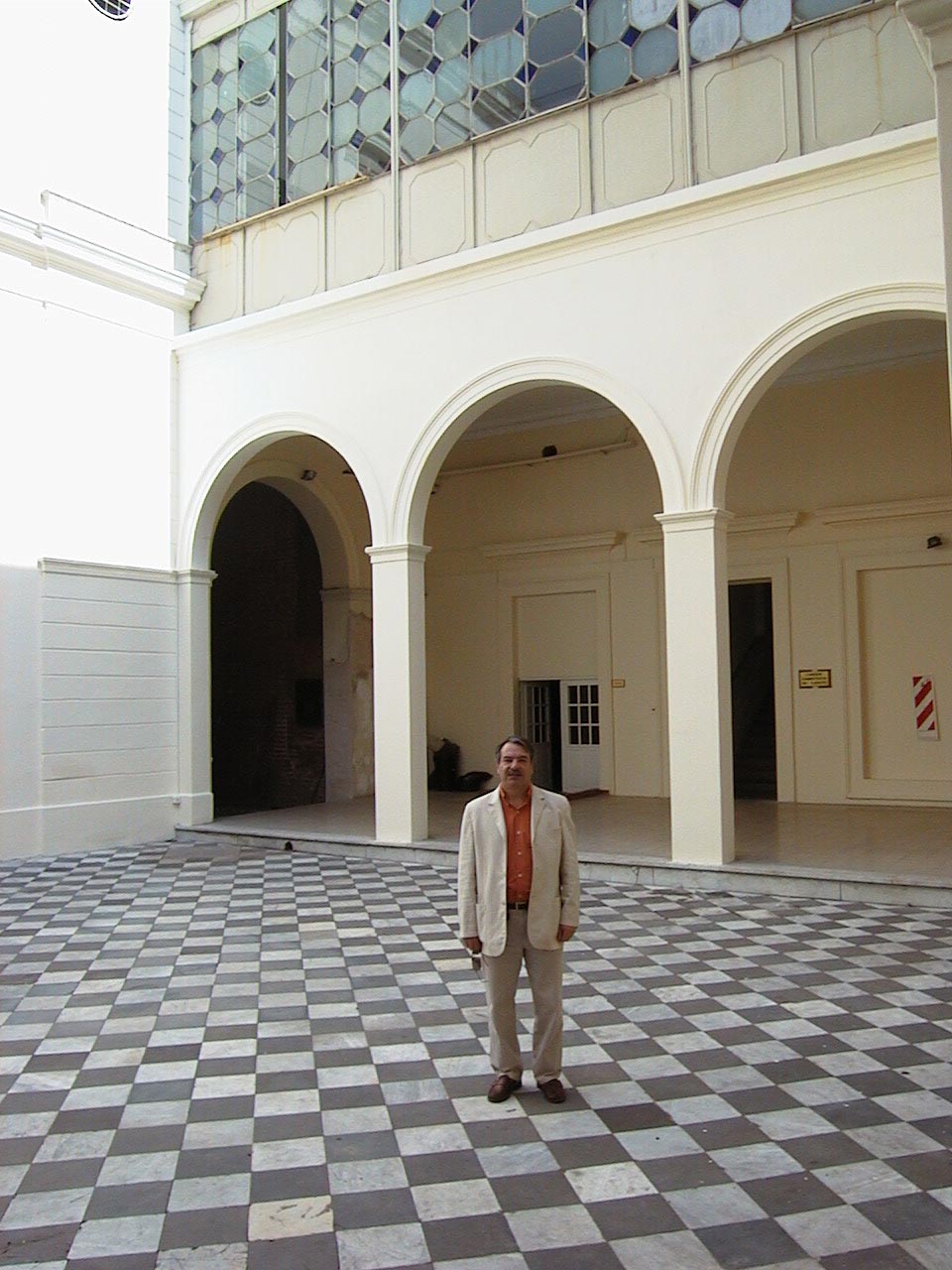
| Las imágenes de arriba, individualizadas como IMAGEN -3- e IMAGEN -4- , respectivamente, corresponden al autor de este sitio Web: David Guevara http://www.historiatdf.com.ar/ y fueron gentilmente registrada durante una visita a la antigua Casa de Moneda Buenos Aires, por el Sr. Héctor Luis Pezzimenti, Director de CEITPA - Centro de Estudio e Investigación de la Tarjeta Postal y Fotografía en Argentina. |
The above views noted as VIEW –2– and VIEW –3– relate to the visit of the author of this web site, David Guevarra http://www.historiatdf.com.ar/ to the old Buenos Aires Mint and were taken by Sr. Héctor Luis Pezzimenti, the Director of CEITPA (the Centro de Estudio e Investigación de la Tarjeta Postal y Fotografía en Argentina) |
![]()
|
Información de interés para numismáticos e historiadores. Se hace saber a numismáticos e investigadores históricos que en el Tomo 2 "HISTORIA DE LA MINERÍA ARGENTINA" - Capítulo 33 - TIERRA DEL FUEGO - David Nelson Federico Guevara - pagina 271 a 292 - Anales 40 - Buenos Aires 2004 - SEGEMAR - (Servicio Geológico Minero Argentino - Av. Julio A. Roca 651 - Piso 10 - (1322) - Buenos Aires - Republica Argentina) se encuentra publicado aspectos de la amonedación de Popper como la primera clasificación de cuños realizado por el autor de este sitio Web. Más abajo se observa dos imágenes correspondiente a la publicación en ingles del NI Bulletin (A Publication of Numismatics International Inc. P.O. Box 570842, Dallas, TX USA 75357-0842 Editor, Herman Blanton hblanton@yahoo.com) - Volume 41 Nº 2 -February 2006, pag 23 a la 42. que contiene un descriptiva e ilustrado trabajp acerca de la amonedación fueguina de Popper, bajo el título: "Tierra del Fuego and the Popper Gold Coins. David Nelson Federico Guevara. |
NEW! Information of interest to numismatics and historians. It is announced to numismatists and historical researches that Volume 2 of "HISTORIA DE LA MINERÍA ARGENTINA" - Capítulo 33 - TIERRA DEL FUEGO - David Nelson Federico Guevara - pages 271 to 292 - Anales 40 - Buenos Aires 2004 - SEGEMAR - (Servicio Geológico Minero Argentino - Av. Julio A. Roca 651 - Piso 10 - (1322) - Buenos Aires - Argentine Republic) has published aspects of the Popper coinage with the first classification of the dies by the author of this web site. Below are two views in the English language publication of the NI Bulletin (A Publication of Numismatics International Inc. P.O. Box 570842, Dallas, TX USA 75357-0842 Editor, Herman Blanton hblanton@yahoo.com) - Volume 41 Nº 2 -February 2006, pages 23 to la 42, which contains an illustrated and descriptive paper on Popper's Fuegian coinage under the heading: "Tierra del Fuego and the Popper Gold Coins." David Nelson Federico Guevara. |
IMAGEN -1-
VIEW –1–
IMAGEN -2-
VIEW –2–
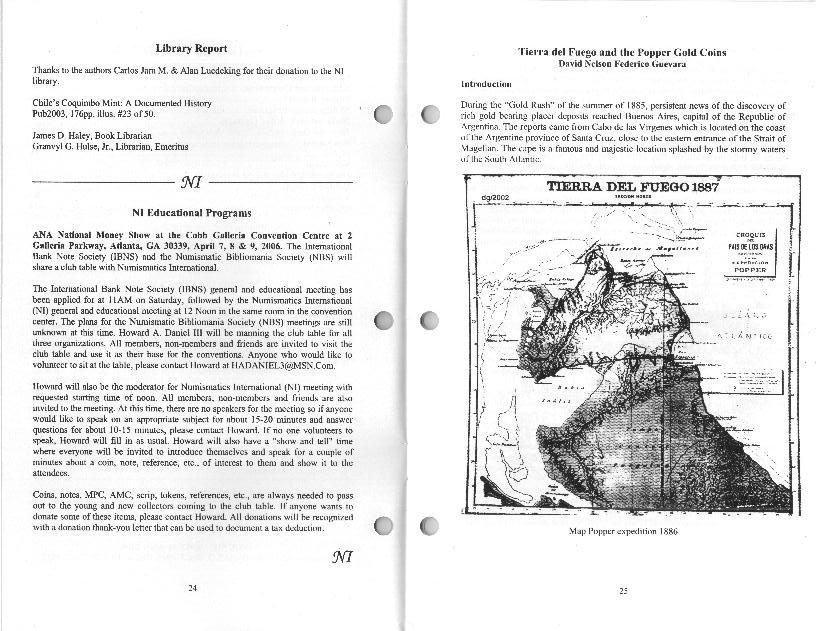
También se incorpora a las novedades numismáticas, dos imágenes del autor de este sitio Web, correspondiente a la series 1 y 3, respectivamente, de la duplicación de la moneda de Popper, realizada en oro por el Museo del Fin del Mundo, Ushuaia (mas abajo en este página hay también un artículo sobre este tema). Se recomienda observar las diferencias en el tamaño del módulo anverso de ambas piezas en la siguiente imagen: It also includes two views, by the author of this web site, corresponding to Series 1 and 3 of the reproduction, in gold, of Popper's coins produced by the Museo Fin del Mundo (World's End Museum), Ushuaia. Further down on this page is an article on this theme. It is worth noting the difference in size between the obverse of the two pieces in the following view.

![]()
![]()
|
El día 17 de Noviembre de 2003, el investigador histórico de Tierra del Fuego y webmaster de este sitio, Sr. David N. F. Guevara, recibió una nota (ver más abajo) fechada, en Buenos Aires el día 28 de Octubre de 2003, de reconocimiento y agradecimiento por parte de la: Academia Argentina de Numismática y Medallística Institución madre y rectora de la actividad numismática en nuestro país - Argentina -, con motivo de su charla, el día 30/09/2003, acerca de: "Popper y sus Moneda de Oro" AGRADECIMIENTO Por la presente el Sr. David Guevara, hace público su reconocimiento y retribuye la generosidad de la nota, a todos los miembros de la Academia, haciendo constar que gestos como estos lo alientan a seguir trabajando en pos de la divulgación de hechos históricos de nuestra querido suelo fueguino y argentino. Río Grande, Tierra del Fuego 28 de Noviembre de 2003. |
On 17 November 2003 the historical researcher of Tierra del Fuego and the Webmaster of this site, Señor David N. F. Guevara, received a note, see below, dated Buenos Aires, 28 October 2003, of recognition and appreciation from: Academia Argentina de Numismática y Medallística The original and guiding institution for numismatics in our country, Argentina, for his contribution to: "Popper y sus Moneda de Oro" 30 September 2003APPRECIATION Señor David Guevara is pleased to advise the public of his recognition and returmns the generosity of the note to all the Members of the Academia, recording that gestures such as this encourage one to continue to work in pursuit of the publication of historical accounts of our beloved Fuegian and Argentine soil. Río Grande, Tierra del Fuego 28 November 2003. |
![]()
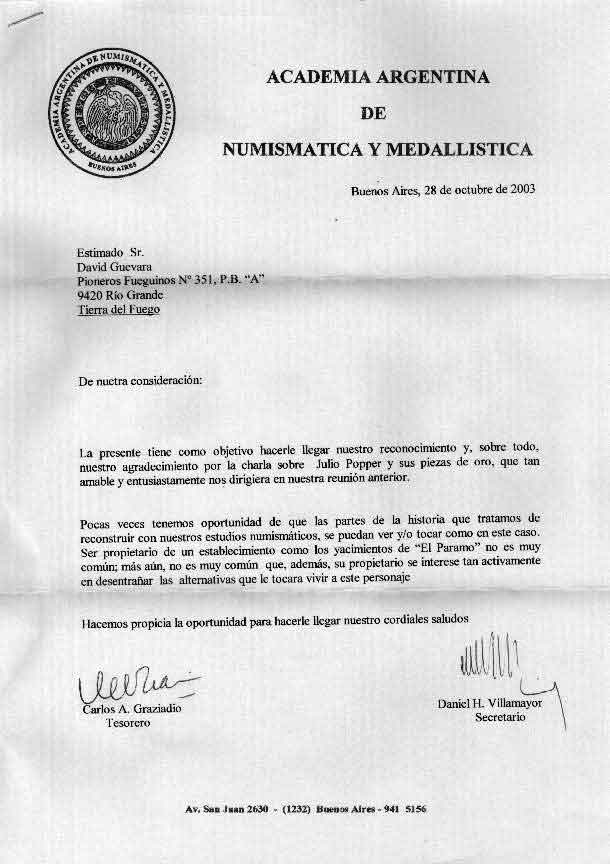
![]()
![]()
![]()
![]()
|
|
||||
|
Moneda de Oro, 5 gramos acuñada en Casa de Moneda de Buenos Aires (Museo Numismático Banco Central de la República Argentina).
(Gentileza del Sr. Jorge R. Villar) |
Gold Coin, 5 grammes, minted in the Buenos Aires Mint (Museo Numismático Banco Central de la República Argentina). (courtesy Señor Jorge R. Villar) |
Moneda de aur de 5 grame, batuta la Monetaria Buenos Aires (Museo Numismatico Banco Central de la Republica Argentina ,Muzeul Numismatic al Bancii Centrale a Republicii Argentina), prin bunavointa d-lui Jorge R. Villar-foto David Guevara. |
Estampilla de Popper 1891, diseñada por el litógrafo austríaco
Rodolfo Soucup e impresa en Buenos Aires por Casa Juan H.Vidd y Cía.
(foto David Guevara) |
Popper‘s Stamp, 1891, designed by the Austrian lithographer Rodolfo Soucup, and printed in Buenos Aires by Casa Juan Kidd y Cía. (photo David Guevara). |
Marca postala emisa de Popper, 1891, desenata de litograful austriac Rodolfo Soucup si imprimata la Buenos Aires de Casa Juan Kidd y Cia. (foto David Guevara |
![]()
|
LAS MONEDAS DE ORO Y ESTAMPILLAS DE POPPER
COPYRIGHT © David N. F. Guevara 1999-2011. Todos los derechos reservados |
Popper‘s Stamps and Gold Coins
Copyright © David N.F. Guevara, 1999–2011.All rights reserved. |
Marcile postale si monedele de aur ale lui PopperCopyright© David N. F. Guevara 1999-2011. Toate drepturile rezervate. |
![]()
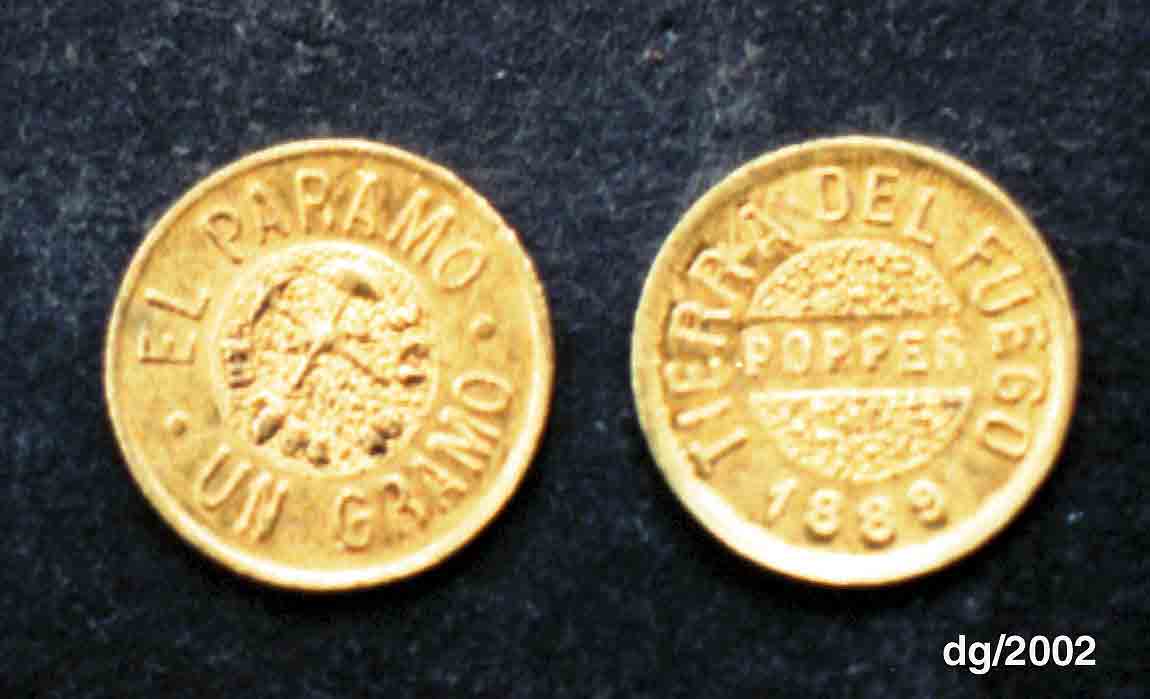
|
Monedas de Oro Acuñadas por Popper en El Páramo, Tierra del Fuego, Argentina (gentileza del Sr. Juan Gomez, Buenos Aires, Argentina) |
Gold Coins Minted by Popper in El Páramo, Argentine Tierra del Fuego (courtesy Señor Juan Goméz, Buenos Aires, Argentina). |
Monedele de aur batute de Popper la El Paramo, Tara de Foc argentiniana (prin bunavointa d-lui Juan Gomez, Buenos Aires, Argentina). |
|
|
|
![]()
|
DUPLICACION DE LAS MONEDAS DE ORO DE POPPER, 1994 La Asociación HANIS (Historia, Antropología y Naturaleza de las Islas del Sud y Antártida), en su condición de entidad intermedia de asesoramiento y cooperación con el Museo del Fin del Mundo (Decreto Territorial Nº 621/79), realizó en el año 1994, con el objeto de constituir un fondo genuino para atender las necesidades del museo, la reproducción limitada de la moneda o ficha de un gramo de oro de Popper, confiando la delicada tarea de hacer los cuños a la empresa "Auro Sur"(1). |
Reproduction of Popper‘s Gold Coins, 1994
The Asociación HANIS (Historia, Antropología y Naturaleza de las Islas del Sud y Antártica – The Society for History Anthropology and the Natural World in the Islands of the South and Antarctica) in their capacity as advisors, and in co-operation with, the Museo Fin del Mundo (Territorial Decree Nº621/79) achieved in 1994 the aim of building a genuine coin press to allow the limited reproduction of Popper‘s 1gramme coins, or tokens, entrusting this delicate task to the Auro Sur company. |
Reproducere a monedelor de aur ale lui Popper
Asociacion HANIS (Asociatia pentru Istoria, Antropologia si Mediul Natural din Insulele de Sud si Antarctica) in calitate de consilier si in cooperare cu Museo Fin del Mundo (Decretul Teritorial Nr. 621/79) a reusit in anul 1994 sa construiasca o matrita care sa permita o emisiune limitata, simbolica, a monedei de 1 gram batuta de Popper, incredintand realizarea ei companiei Auro Sur. |
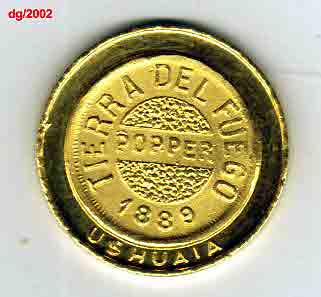
|
Arriba duplicación Moneda de Oro de Popper, SERIE I, realizada por el Museo del Fin del Mundo Ushuaia, Argentina (HANIS- Año 1994) |
Above reproduction of Popper‘s Gold Coin undertaken by the Museo del Fin del Mundo, Ushuaia, Argentina (HANIS, 1994) |
Replica a monedei de aur a lui Popper ralizata de Museo del Fin del Mundo, Ushuaia, Argentina (HANIS, 1994). |
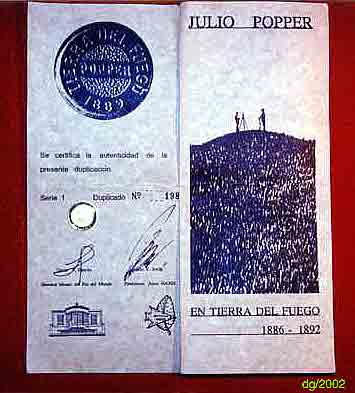
Certificado de Duplicación Moneda Popper
Certificate of Reproduction of a Popper Coin
Certificatul replicii unei monede Popper
|
Estas interesantes reproducciones del medio de pago emitido por Popper, actualmente se comercializan en el citado museo en forma numerada y con certificado de autenticidad de la duplicación. |
These interesting reproductions of the currency issued by Popper, are currently sold in the museum, numbered and certified as to their authentic reproduction. |
Aceasta interesanta replica a monedei emise de Popper se vinde in mod curent in muzeu, inseriata si certificata pentru autenticitate. |
![]()
|
Las Monedas de Oro de Popper Popper durante la permanencia en suelo fueguino acuñó monedas y/o medallas y/o fichas de oro, los estudiosos en materia numismática que profundizaron sus investigaciones sobre esta limitada y curiosa amonedación fueguina no han podido precisar que cantidad de metal fué amonedada en el legendario y afamado establecimiento minero de El Páramo, aunque estiman que ha sido importante, en particular las piezas de oro de 1 gramo y en menor cantidad las de 5 gramos.
Una buena y útil referencia sobre estas acuñaciones, la dió el propio Popper cuando en Julio de 1892 remitió a Don Bartolome Mitre y Vedia. hijo del General Mitre, su importante colección de monedas fueguinas junto a una breve pero descriptiva carta donde brindó detalles sobre los valores y variedad de las distintas emisiones en oro.
La misma confirmó la acuñación de piezas de 1 y 5 gramos, como salidas de Casa de Moneda de Buenos Aires, emisión diez mil gramos de oro nativo y sin liga de Tierra del Fuego (Ley Oro 864, Plata 132) y permitió estimar a los investigadores que se acuñaron en esa oportunidad 1.000 piezas de 5 gramos y 5.000 de 1 gramo. Asimismo estableció en forma práctica una clasificación sencilla para recordar y que se detalla a continuación:
LETRA VALOR LUGAR DE EMISION A 5 GRAMOS EL PARAMO B 1 GRAMO EL PARAMO C 5 GRAMOS CASA DE MONEDA D 1 GRAMO CASA DE MONEDA E 1 GRAMO CASA DE MONEDA
Sin embargo se ha constatado otros registros donde figuran unos 175.000 gramos de oro como remitidos para su acuñación a Casa de Moneda de Buenos Aires y la existencia de otras piezas que sin estar incluidas en esta clasificación de Popper son consideradas por parte de los expertos numismáticos como genuinas.
También se conservan varios de los cuños labrados en el lejano establecimiento minero de Tierra del Fuego y los confeccionados en Casa de Moneda de Buenos Aires. Estos estan resguardados en el Museo del Fin del Mundo y en el Museo Numismático del Banco de la Nación Argentina en Buenos Aires, República Argentina. |
Popper’s Gold Coins
Popper, while in Tierra del Fuego, minted gold coins. Students of numismatics who have researched this limited and unusual Fugean coinage have not been able to determine exactly how much metal was coined in the legendary and famed mining centre of El Páramo, although, they estimate that it was significant, particularly the 1 gramme coins, with a lesser number of 5 gramme coins.
A good and easy reference to these mintings was given by Popper himself in July 1892, when he sent to Don Bartolome Mitre y Vedia, son of General Mitre, his important collection of Fugean coins, along with a brief, but descriptive, letter in which he gave information about the values and varieties of the various issues of gold coins.
That letter confirmed the minting of 1 and 5 gramme pieces by the Buenos Aires Mint, amounting to ten thousand grammes of unalloyed natural gold from Tierra del Fuego (864 parts per thousand gold; 132 parts silver) and this allowed the researchers to estimate that some 1,000 5gramme coins and 5,000 1gramme ones could have been produced there. Similarly a simple practical classification of these coins was devised:
Letter Value Issued at A 5 grammes El Páramo B 1 gramme El Páramo C 5 grammes BA Mint D 1 gramme BA Mint E 1 gramme BA Mint
Nevertheless, other records suggest that some 175,000 grammes of gold were sent for minting to the Buenos Aires Mint, and that there are other coins which are not included in this classification by Popper, but which are considered genuine by numismatic experts.
Also preserved are some of the coin dies made in that far-away mining establishment in Tierra del Fuego and those made in the Buenos Aires Mint. These are preserved in the Museo del Fin del Mundo and in the Museo Numismático del Banco de la Nación Argentina in Buenos Aires, Argentine Republic. |
Monedele de aur ale lui Popper
In timpul sederii sale in Tara de Foc Popper a batut moneda de aur. Studentii si numismatii care au cercetat aceasta neobisnuita si limitata emisiune monetara n-au reusit sa stabileasca precis cantitatea de aur transformat in monede la exploatarea El Paramo dar pe care o considera semnificativa pentru monedele de 1 gram si mult mai mica pentru cele de 5 grame.
O referinta utila si accesibila asupra emisiunii acestor monede o da Popper insusi, in iulie 1892 cand trimite lui Don Bartolome Mitre y Vedia, fiul generalului Mitre, importanta sa colectie de monede batute in Tara de Foc, impreuna cu o scrisoare scurta dar precisa in care da informatii asupra valorii si varietatii deiferitelor emisiuni ale monedelor de aur.
Scrisoarea confirma emisiunea pieselor de 1 si 5 grame de catre Monetaria Buenos Aires in cantitate de zece mii de grame de aur nativ din Tara de Foc (864 parti la mie aur, 132 parti argint), ceea ce a permis cercetatorilor sa estimeze emisiunea monetara in discutie la 1000 de monede de 5 grame si 5000 de monede de 1 gram.In mod similar a fost dedusa o clasificare practica a acestor monede:
Litera Valoarea Emisa la
A 5 grame El Paramo B 1 gram El Paramo C 5 grame Monetaria Buenos Aires D 1 gram Monetaria Buenos Aires E 1 gram Monetaria Buenos Aires
Cu toate acestea, alte studii sugereaza ca la Monetaria Buenos Aires au fost trimise pentru baterea acestor monede 175 000 grame de aur si de aceea mai exista si alte monede, care nu sunt incluse in clasificarea lui Popper dar pe care expertii numismati le considera autentice.
S-au pastrat deasemenea cateva matrite ale monedelor fabricate fie in indepartata exploatare miniera din Tara de Foc fie la Monetaria Buenos Aires.Acestea sunt pastrate la Museo del Fin del Mundo si la Museo Numismatico del Banco de la Nacion din Buenos Aires, Republica Argentina.
|

| Moneda de Oro, 1889, un gramo oro, acuñada en el Establecimiento Minero de el "El Páramo" por el Ingeniero rumano Julio Popper. Tierra del Fuego. República Argentina. Pieza perteneciente a la Colección Museo Numismático Banco Central de la República Argentina. (Gentileza del Señor Jorge Rodolfo Villar) |
Gold Coin, 1889, 1 gramme of gold, minted in the El Páramo mining centre, Argentine Tierra del Fuego, by the Romanian engineer, Julio Popper. The coin belongs to the collection of the Museo Numismático Banco Central de la República Argentina (courtesy Señor Jorge Rodolfo Villar). |
Moneda de aur de 1 gram, 1889, batuta la exploatarea miniera El Paramo, Tara de Foc argentiniana de catre inginerul roman Julio Popper. Moneda apartine colectiei Muzeului Numismatic al Bancii Centrale a Republicii Argentina ( prin bunavointa d-lui Jorge Rodolfo Villar).
|
![]()
|
LAS ESTAMPILLAS Las estampillas o "marcas" de 10 centavos oro, emitidas por el Ingeniero Julio Popper fué diseñada por el litógrafo austríaco Rodolfo Soucup e impresa por la Casa Juan H.Kidd y Cía. de Buenos Aires, impresores para aquella época de sellos postales argentinos. Las mismas fueron impresas en pliegos de 100 sellos de 10x10 y ostentaban en el margen superior el nombre de la casa impresora, siendo su verdadero color de un carmesí rosado. |
The Stamps
The stamps of 10 gold centavos, issued by the engineer Julio Popper, were designed by the Austrian lithographer Rodolfo Soucup and printed by Casa Juan H. Kidd y Cía of Buenos Aires, the printers of Argentine postage stamps at that time.
The stamps were printed in sheets of one hundred stamps, in ten rows by ten columns, and had the printer‘s name on the top margin. Their true colour was a rosy crimson. |
Marcile postale
Marcile postale de 10 centavos de aur, emise de inginerul Julio Popper au fost desenate de litograful austriac Rodolfo Soucup si imprimate la Casa Juan H. Kidd y Cia din Buenos Aires, care in epoca imprima timbrele pentru Posta argentiniana.
Marcile postale erau imprimate pe coli de cate o suta de timbre, pe zece coloane de cate zece randuri avand numele tipografului imprimat pe manseta de sus. Culoarea originala era trandafiriu aprins. |

![]()
![]()
VISITE LOS ENLACES RECOMENDADOS
VISIT THE LINKS RECOMMENDED

Federación de Entidades Numismáticas y Medallísticas Argentinas:
![]()
![]()
Dan Grecu
e-mail: dang@deva.iiruc.ro
Web Pages Dan Grecu:
- "Romanian Postal History Page": http://membres.lycos.fr/dgrecu
![]()
REGRESO A LA PAGINA PRINCIPAL (RETURN TO HOME PAGE)
REGRESO AL MENU DE CONTENIDOS (RETURN TO THE CONTENTS MENU)